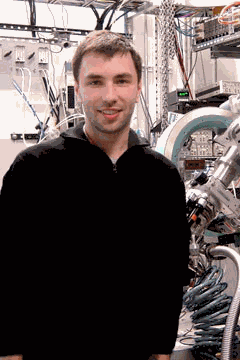The Advanced Photon Source (APS) Users Organization has named Oleg G. Shpyrko of the University of California, San Diego, as the recipient of the 2008 Rosalind Franklin Young Investigator Award. The award recognizes an important technical or scientific accomplishment by a young investigator that depended on, or is beneficial to, the APS. Shpyrko will receive the award on May 5 at the 2008 Users Week at Argonne National Laboratory, where he will also present his work.
Shpyrko is cited for reaching a remarkably high level of achievement very early in his career. In particular he is recognized for applying challenging surface and coherent x-ray scattering techniques to understanding the structure and dynamics of liquid-metal surfaces and quantum states in condensed matter systems. He is also recognized as a dedicated and enthusiastic teacher.
Shpyrko received his Ph.D. in 2004 from Harvard University under the direction of Peter Pershan; he then held postdoctoral fellowships at Harvard and at the Argonne Center for Nanoscale Materials before joining the faculty of the Physics Department at the University of California, San Diego in 2007.
Most recently, as a postdoctoral fellow at Argonne, Shpyrko studied domain wall fluctuations in antiferromagnets, technologically important materials used to tailor the properties of magnetic sensors used in hard-drive read heads. In antiferromagnets, magnetic properties vary spatially at the nanoscale, forming distinct regions called “domains.” Fluctuations in the domain boundaries or walls were expected to cause magnetic noise that could affect the material’s performance. However, certain characteristics of these antiferromagnetic domains rendered them invisible to conventional techniques.
Shpyrko applied the newly developed technique x-ray photon correlation spectroscopy at X-ray Operations and Research (XOR) beamlines 33-ID and 8-ID to observe fluctuations of these domain walls for the first time. This technique exploits an exceptional property of the APS, the coherence of its x-ray beams. An important finding was a crossover from classical to quantum behavior at low temperatures, indicating that magnetic noise cannot be eliminated. The ability to observe domain wall fluctuation is important both for engineering tailored materials and for fundamental studies in condensed matter physics.
For his thesis work—using another very challenging experimental method—Shpyrko resolved a long-standing controversy on whether or not atomic layering is unique to liquid metals. He used x-ray surface scattering techniques at XOR beamline 9-ID and ChemMatCARS beamline 15-ID to compare the surface structure in high-surface-tension liquid metals, such as tin or indium, with the surface structure in low-surface-tension alkali metals and nonmetallic liquids. The results showed layering in alkali metals but no layering in water. This observation strongly indicates that layering is unique to metallic liquids and that it arises from electronic properties rather than from high surface tension, as other groups have argued from theory.
Shpyrko has continued to study the surface properties of liquid metals, working in particular with gold silicide (AuSi), a solder used in nanoscale circuitry. In contrast to the previously observed behavior of other liquid alloys and pure liquid metals, a nondilute liquid eutectic gold-silicon alloy (Au82Si18) developed both a crystallized alloy “skin” and an ordered structure extending several atomic layers into the bulk. The “skin” remained an alloy, rather than segregating to a pure metal as in other liquid alloys. The results are important because properties at the nanoscale, including the effectiveness of AuSi as a nanoscale solder, are expected to depend heavily on surface effects.
Future directions include development of novel coherent scattering and imaging techniques, such as ptychography, a form of lensless x-ray microscopy that allows for imaging of extended objects with nanoscale resolution by inverting the coherent diffraction pattern, therefore bypassing the need for objective lenses. These techniques will be especially useful for studying domain formation, emerging behavior, and phase transitions in inhomogeneous or nanoscale phase-separated systems. Shpyrko continues to work on liquid surface scattering, studying how nanoscale confinement affects surface dynamics in fluids, colloidal nanoparticles, and self-assembled monolayers.
Antiferromagnetic domains
O. G. Shpyrko, E. D. Isaacs, J. M. Logan, Yejun Feng, G. Aeppli, R. Jaramillo, H. C. Kim, T. F. Rosenbaum, P. Zschack, M. Sprung, S. Narayanan, and A. R. Sandy, “Direct measurement of Antiferromagnetic Domain Fluctuations,” Nature 447, 68 (3 May 2007). DOI:10.1038/nature05776
Layering in liquid metals
O. G. Shpyrko, A. Yu. Grigoriev, R. Streitel, D. Pontoni, P. S. Pershan, M. Deutsch, B. Ocko, M. Meron, and B. Lin, “Atomic-Scale Surface Demixing in a Eutectic Liquid BiSn Alloy,” Phys. Rev. Lett. 95, 106103 (2005).
O. G. Shpryko, R. Streitel, V. S. K. Balagurusamy, A. Yu. Grigoriev, M. Deutsch, B. M. Ocko, M. Meron, B. Lin, and P. S. Pershan, “Surface Crystallization in a Liquid AuSi Alloy,” Science 313(5738), 77 (7 July 2006). DOI: 10.1126/science.1128314
Current work
Oleg Shpyrko’s publications and current research directions are highlighted at his University of California, San Diego, Web site, http://oleg.ucsd.edu.

